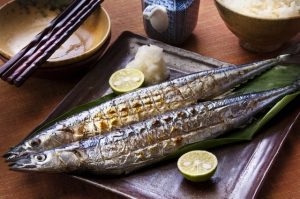
A mix of trees outside of Houkoku Temple
In Japan, autumn is considered a time of change, a time to break the habit of escaping the summer heat, and getting the most recreational outdoor time before winter. It is a time where the trees change color and the final fruits fall from their branches. Japan has several expressions to articulate this season that lies between the sweltering summer and chilly winter: “the autumn season of sports”, “the season of appetites”, and “the season of reading”. Why is it that the Japanese have associated these three aspects with autumn? And as someone visiting or living in Japan what can I do to maximize my “Japanese experience” during this season?
First on the list is probably the simplest to justify: “autumn, the season of sports”. Autumn temperatures in Japan can best be described as mild, moderate, and dry. In the summer people tend to focus on indoor and non-sweat inducing activities like seeing a movie or going to the mall. When prompted as to what they do during the summer, very few Japanese people conjure up physical activities. But as temperatures become cooler, and light jackets become the norm, you can often see more people crowding the streets. Fewer people line up to take the bus and instead go to their destination by foot or by bicycle. Recreational sports like jogging, cycling, and swimming become the go-to for staying physically active. There is even a holiday in autumn called “Sport’s Day” (on the second Monday of October) to promote getting outdoors before the winter winds blow in.
For those who are not into physical activity, autumn is the best time to crack open a book as it is considered to be “the season of reading”. Autumn brings a refreshing change of humidity as the air becomes crisp. For people looking to soak in the most sunshine as the nights get long reading is the ideal activity. Now you might be thinking, “reading!? I can do that anytime, day or night. What makes autumn so special?” Well, sitting on a park bench enjoying a good book is very hard to do during the rainy season, the sweltering summer, or the chilly windy winter days. But autumn’s gentle breeze makes it the perfect season to get lost in another world without being eaten alive by mosquitoes or freezing your fingers. Japan has a very active writing scene with new books hitting shelves everyday in almost any genre imaginable. What is also interesting is that Japanese prefer physical paperback books to their digital counterparts. Reading is one most common activities during the workday train commute.

Grilled Sanma
Autumn in agricultural parts of Japan is a time to prepare for winter; farmers begin their final harvest as well as collecting nuts and fruits from trees. Fresh food is plentiful hence “the season of appetites”. Foods typically eaten in autumn are things like chestnuts, freshly harvested rice, and matsutake(松茸) mushrooms. For fish, it is the season of sanma (秋刀魚), or in English, mackerel pike. Sanma is commonly prepared by charcoal fire and eaten whole. If you are not familiar with dissecting a fish with chopsticks or spotting bones in your fish this will be great practice!
While not as popular as cherry tree blossoms, the various colored leaves of autumn are something to behold, especially when you live and work in Tokyo where nature is sparse among the tall buildings. For those living in the Tokyo/Yokohama urban sprawl and for people visiting, one of the best ways to check out the autumn leaves (紅葉, momiji) is making a day trip to Kamakura (鎌倉). Kamakura is just south of Yokohama and very easy to get to by train. The small city is a bustling rural area surrounded by temples and lush greenery. Temples like Houkoku Temple (報国寺, houkoku-ji) and Jyomyo Temple (浄妙寺, jyoumyou-ji) are not only rich in history but have various types of trees providing excellent photo opportunities. While in Kamakura you can enjoy the local eats: Kamakura’s special varieties of sausages, unique hamburgers, and for dessert try the sweet potato ice cream.

Nothing beats a calm walk
All in all autumn is a great time to be in Japan: people are not just hustling and bustling from one building to the other, trying to avoid the heat, the cold, or the rain; but are taking in the cool air and enjoying the leaves changing colors. As a tourist there are many places to enjoy the sports, good food, and autumn colors like Kamakura, Kyoto, and Hokkaido. You just have to find out when the best time is because it varies by region. So don’t think Japan is just best to visit in the spring, it is fantastic, but you surely will not be disappointed in autumn. And don’t forget a good book.
J.J.
Software Engineer and Blogger at TalentHub
Usually coding, writing, or exploring Japan.
Read more TalentHub blogs : https://talenthub.jp/blog/?lang=en









